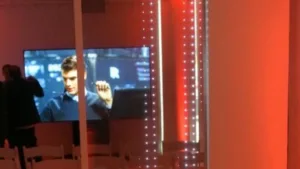LG Business Solutions held its New York City Roadshow on November 2 in an event venue on 10th Avenue near 31st Street. The area is called Hudson Yards for the railroad yards that dominated the area for decades, an area that was otherwise an inaccessible backwater despite the proximity of the Jacob Javits Convention Center.

But the recent extension of the Number 7 subway line and covering over the rail lines has opened the area to energetic luxury development, with many high-rise buildings under simultaneous construction. When you get to the construction cranes and the construction guys eating their lunches on the sidewalks, you know you’re there (Fig. 1).
Fig. 1. The LG Business Solutions Roadshow was held at an event menu in New York City’s Hudson Yards, a huge construction site that will soon be a forest of luxury high-rise buildings. (Photo: Ken Werner)
Gary Kayye of rAVe Publlications and Kayye Consulting presented a morning keynote that was primarily an introductory tutorial on why 4K is good for AV and commercial displays. Kayye pushed the 4K Digital Canvas concept, which he defined as multiple screen covering the walls in a conference room, with some screens having static reference information and others dynamic imagery related to the ongoing presentation or discussion. One version of this is the “collaboration room.” etc. There aren’t many installations now because of the scarcity of 4K material and distribution, but many more are coming in the next year, Kayye said.
If any of this was too basic to hold your interest, you were free to wander, look at the various business solutions, and discuss them with one of the many enthusiastic and well-trained LG representatives.
The most striking solution consisted of two flexible LG OLED displays mounted back to back and laminated between two sheets of glass. This assembly was demonstrated in a variety of configurations; perhaps the most striking was the 55EG5CD, in which the displays were suspended by wires and fed by a ribbon cable (Fig. 2).
Fig. 2. One of the LG’s many applications for its Wallpaper OLED panel, is to mount two of them back to back, laminate them between two sheets of glass and hang them from wires for a very striking display. (Photo: Ken Werner)
The unit has three-year commercial warranty for 18 hrs/day, 7 days/week interior use. A rep said there has not much pushback from retail customers on 18 hours a day rather than 24. There is no problem with dynamic content, the rep said, but LG recommends against the use of static content. Suggested applications are boutiques, art galleries, and high-end retail.
I had an extensive interview with VP of Business Development Dan Smith, both of us standing on the exhibition floor and pointing at the different systems as we discussed them. I commented that the Roadshow seemed to be pushing OLED solutions since OLED was at the center of at least half of the demonstrations. Smith answered that LG Business Solutions is only provider that offers OLED, LCD, LED, and outdoor LCD products, so they are free to offer the technology best suited for each customer’s application.
OLED TV in high-end hospitality systems was prominently featured. Is there any pushback on cost? “Well”, Smith said with a laugh, “we don’t try to sell it to Motel 6.” But there is lots of interest from high-end hotel brands.
Smith unknowingly repeated the comment of his rep that LG does not recommend static on OLED signs, but they do have OLED wayfinding signs in an airport with custom-created imagery that avoids static areas.
For 24/7 applications such as fast-food menu boards, they recommend LCD. MacDonalds is a major LG customer, Smith said.
Smith commented that burn-in is only one of the two major sources of OLED image sticking. Another is residual charge in pixel switching circuits. LG deals with both, he said. In general, OLED
performance has improved significantly over the last 2 years, Smith said, including greater accuracy of the transfer function. OLED lifetime is 30,000 hours, compared with 50,000 for LCD, Smith added, and there is no problem with lifetime in either TV or dynamic-signage applications.
Smith emphasized that the “wallpaper OLED” is flexible but is generally laminated onto or between glass. As a business-development person, he sees it is a powerful building block for making a variety of customer solutions.
A very high-aspect-ratio 86-inch and wider 88-inch stretch display for columns are both resized from a 98-inch LCD. The 86 stretch is 84 x 13 inches with a resolution of 3840 x 600 pixels. The 88 stretch is 3840 x 1080 — one half of a 98-inch LCD.
My tour ended with a decorative LED display fabricated on transparent film (Fig. 3). The electronics are contained in the strip on the edge of the display. (The strip is much narrower than the one in the photo, which had to serve a structural function.) Two films can be mounted side by side, with the electronic strips on outside. Smith said the transparent display is intended to be applied to shop windows to attract attention. (It’s monochrome at the moment, but the company told us earlier this year that it is looking to develop a colour version – Man. Ed.) – Ken Werner
Fig. 3. LG’s transparent LED display film is intended as a shop-window attention-getter. (Photo: Ken Werner)
Ken Werner is Principal of Nutmeg Consultants, specializing in the display industry, manufacturing, technology, and applications, including mobile devices, automotive, and television. He consults for attorneys, investment analysts, and companies re-positioning themselves within the display industry or using displays in their products. He is the 2017 recipient of the Society for Information Display’s Lewis and Beatrice Winner Award. You can reach him at [email protected].

